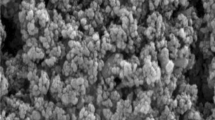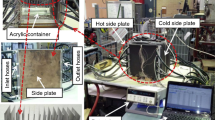A survey of the constructions of heat pipes and thermosiphons with nanofluids, nanocoatings, and nanocomposites based on metal oxides and carbon materials for volume absorption of solar energy and cooling of electronic components is presented. Nanofluids are considered as actual working media intended for application in transparent heat miniexchangers, heat pipes, and thermosiphons for volume heating a nanofluid by laser or solar radiation. Nanocoatings of the evaporator walls of heat pipes are created for intensifying two-phase heat transfer in cooling the devices of high-current electronics. Nanocomposites applied as heat pipe and thermosiphon casings possess thermophysical and mechanical properties that in a number of cases are best than those from metals.
Similar content being viewed by others
References
Bengt Sundén, Impact of micro- and nanostructures and nanofluids on heat transfer performance, 5th Int. Workshop on Heat/Mass Transfer Advances for Energy Conservation and Pollution Control (IWHT2019), 13−16 August 2019, Novosibirsk Akademgorodok (Russia).
M. Hernaiz, V. Alonso, P. Estellé, Z. Wu, B. Sundén, L. Doretti, S. Mancin, N. Çobanoğlu, Z. H. Karadeniz, N. Garmendia, M. Lasheras-Zubiate, L. Hernández López, R. Mondragón, R. Martínez-Cuenca, S. Barison, A. Kujawska, A. Turgut, A. Amigo, G. Huminic, A. Huminic, M.-R. Kalus, K.-G. Schroth, and M. H. Buschmann, The contact angle of nanofluids as thermophysical property, J. Colloid Interface Sci., 547, 393−406 (2019).
A. Naser, Joao A. Teixeira, and A. Addali, A review on nanofluids: Fabrication, stability, and thermophysical properties, J. Nanomater. (2018); https://doi.org/https://doi.org/10.1155/2018/6978130.
L. L. Vasiliev, L. P. Grakovich, M. I. Rabetsky, and L. L. Vassiliev Jr., Heat transfer enhancement in heat pipes and thermosyphons using nanotechnologies (nanofluids, nanocoating, and nanocomposites), Heat Pipe Sci. Technol., Int. J., 4, No. 4, 251−275 (2013).
F. Q. Wang, M. Hu, and Q. Wang, Ultrahigh thermal conductivity of carbon allotropes with correlations with the scaled Pugh ratio, J. Mater. Chem. A, 7, Issue 11, 6259–6266 (2019).
Wei Wang, Zan Wu, Bingxi Li, and Bengt Sundén, A review on molten-salt-based and ionic-liquid-based nanofluids for medium-to-high temperature heat transfer, J. Therm. Anal. Calorim., No. 136, 037–1051 (2019).
Leonard Vasiliev, Heat pipes with nanocomposites — Analysis and applications, 3rd Int. Conf. "Defreezing the Anomalies of Fluid Dynamics and Aerodynamics, on Fluid Dynamics & Aerodynamics," October 25−26, 2018, Berlin, Germany (2018).
L. L. Vasiliev, Heat pipes with nanocomposites for renewable sources of energy application, in: Nanostructures in Condensed Media, Collect. Sci. Papers, Minsk (Belarus), Vol. 2, 293−303 (2018).
Yu. M. Nikolenko, V. G. Kuryavyi, I. V. Sheveleva, L. A. Zemskova, and V. I. Sergienko, Investigation of fibrous chitosan–carbon materials by the methods of atomic power microscopy and x-ray photoelectronic spectroscopy, Neorg. Mater., 46, No. 3, 266−271 (2010).
A. I. Rat’ko, V. F. Romanenkov, E. V. Bolotnikova, and Zh. V. Krupen’kina, Influence of thermal dehydratation of bayerite on the absorption-structural properties and mechanical strength of the porous composite Al/Al2O3, Dokl. Akad. Nauk Belarusi, 47, No. 5, 62−65 (2003).
L. Vasiliev, L. Kanonchik, M. Kuzmich, and V. Kulikouski, Development of adsorptive natural gas storage system with thermosyphons thermal control, 5th Int. Workshop on Heat/Mass Transfer Advances for Energy Conservation and Pollution Control, August 13−16, 2019, Novosibirsk, Russia (2019).
Zhen Cao, Bin Liu, Calle Preger, Zan Wu, Yonghai Zhang, Xueli Wang, Maria E. Deppert, Knut Deppert, Jinjia Wei, and Bengt Sundén, Pool boiling heat transfer of FC-72 on pin-fin silicon surfaces with nanoparticle deposition, Int. J. Heat Mass Transf., 126, 1019−1033 (2018).
L. A. Zemskova, I. V. Sheveleva, and V. Yu. Glushchenko, Electrochemical methods of concentration on electrodes made from carbon fibrous materials, Khim. Tekhnol., No. 7, 6–11 (2004).
L. H. R. Cisterna, M. C. K. Cardoso, E. L. Fronza, F. H. Milanez, and M. B. H. Mantelli, Operation regimes and heat transfer coefficients in sodium two-phase thermosyphons, Int. J. Heat Mass Transf., 152, Article 119555 (2020).
A. Chauhan and S. G. Kandlikar, Characterization of a dual taper thermosyphon loop for CPU cooling in data centers, Appl. Therm. Eng., 146, 450−458 (2019).
J. Kim, J. Oh, and H. Lee, Review on battery thermal management system for electric vehicles, Appl. Therm. Eng., 149, 192−212 (2019).
C. Lu, W. Ji, J. Yang, W. Cai, T. Wang, C. Cheng, and H. Xiao, Experimental and computational analysis of a passive containment cooling system with closed-loop heat pipe technology, Prog. Nucl. Energy, 113, 206−214 (2019).
M. A. Ebadian and C. X. Lin, A review of high-heat-flux heat removal technologies, J. Heat Transf., 133, No. 11, 1–11 (2011).
P. A. Vityaz’ and É. M. Shpilevskii, Nanostructures in condensed media: Achievements and prospects, in: Fullerenes and Nanostructures in Condensed Media, Collect. Sci. Papers, Minsk (2018), pp. 3−8.
Leonid Vassiliev, Heat Exchange Device Made of Polymeric Material, WO 2010055542 A2.
L. L. Vasiliev, L. L. Vassiliev Jr., M. I. Rabetsky, L. P. Grakovich, A. S. Zhuravlyov, A. V. Shapovalov, and A. V. Rodin, Long horizontal vapordynamic thermosyphons for renewable energy sources, Heat Transfer Eng., 40, Issues 3−4, 258−266 (2018).
L. L. Vasiliev, M. I. Rabetsky, L. P. Grakovich, and A. S. Zhuravlyov, Loop thermosyphon as one-turn annular pulsating heat pipe, Int. J. Res. Eng. Sci., 7, Issue 2, Ser. 1, 19–32 (2019).
L. L. Vasiliev, M. I. Rabetsky, L. P. Grakovich, V. K. Kulikouski, A. S. Zhuravlyov, and M. A. Kuzmich, Loop thermosyphons with porous coating and horizontally disposed evaporator and condenser, Joint 19th IHPC and 13th IHPS, June 10–14, 2018, Pisa, Italy (2018).
L. G. Krasnevskii, Automatic transmissions: Analysis and prospects of application in hybrid and battery electric vehicles. Pt. 1, Mechanics of Machines, Mechanisms, and Materials, 51, No. 2, 16–29 (2020).
L. G. Krasnevskii, Automatic transmissions: Analysis and prospects of application in hybrid and battery electric vehicles. Pt. 2, Mechanics of Machines, Mechanisms, and Materials, 52, No. 3, 12–26 (2020).
L. E. Kanonchik and L. L. Vasiliev, Charge dynamics of a low-pressure natural gas accumulator with solid adsorbent, novel thermosyphon and recirculation loop, Int. J. Heat Mass Transf., September 2019; DOI: https://doi.org/10.1016/j.ijheatmasstransfer.2019.07.024.
Author information
Authors and Affiliations
Corresponding author
Additional information
Translated from Inzhenerno-Fizicheskii Zhurnal, Vol. 94, No. 5, pp. 1245–1254, September–October, 2021.
Rights and permissions
About this article
Cite this article
Vasiliev, L.L. Heat Pipes, Nanofluids, and Nanotechnologies. J Eng Phys Thermophy 94, 1217–1226 (2021). https://doi.org/10.1007/s10891-021-02402-w
Received:
Published:
Issue Date:
DOI: https://doi.org/10.1007/s10891-021-02402-w




